Abstract
Experiments were conducted to determine whether allelochemicals released by the important medicinal plant Scutellaria baicalensis Georgi help to explain why S. baicalensis performs poorly when continuously cropped. Based on high performance liquid chromatography, the concentration of baicalin (the major compound released by S. baicalensis roots) in the soil where S. baicalensi had been grown for 3 years was 0.97 µg.g−1. Both the crude extracts from S. baicalensis roots and purified baicalin at 0.97 µg.g−1 increased the mortality of S. baicalensis seedlings in an autotoxicity test. This concentration stimulated the growth of two soilborne pathogens (Pythium ultimum and Rhizoctonia solani) on agar, and their growth and pathogenic activity in sand. Seedling mortality and damping-off caused by both pathogens were greater in sand where S. canadensis had previously grown than in sand where it had not previously grown. Mortality and damping-off of S. baicalensis seedlings also were significantly higher in soil collected from an S. baicalensis field than in soil collected from a Nicotiana tabacum L. field. The results are consistent with the hypothesis that allelochemicals released by S. baicalensis negatively affect S. baicalensis directly by inducing autotoxicity and indirectly by increasing pathogen activity in the soil.



Similar content being viewed by others
References
Bais, H. P., Park, S. W., Weir, T. L., Callaway, R. M., and Vivanco, J. M. 2004. How plants communicate using the underground information superhighway. Trends Plant Sci. 9: 26–32.
Bastida, F., Kandeler, E., Moreno, J. L., Ros, M., Garcia, C., and Hernandez, T. 2008. Application of fresh and composted organic wastes modifies structure, size and activity of soil microbial community under semiarid climate. Appl. Soil Ecol. 40: 318–329.
Batish, D. R., Singh, H. P., Kohli, R. K. and Kaur, S. 2001. Crop allelopathy and its role in ecological agriculture. J. Crop Prod. 4: 121–162.
Beckstead, J. and Parker, I. M. 2003. Invasiveness of Ammophila arenaria: release from soil-borne pathogens? Ecology 84: 2824–2831.
Ben-Hammouda, M., Ghorbal, M. H., Kremer, R. J., and Oueslati, O. 2002. Autotoxicity of barley. J. Plant Nutri. 25:1155–1161.
Benizri, E., Piutti, S., Verger, S., Pagès, L., Vercambre, G., Poessel, J. L., and Michelot, P. 2005. Replant diseases: bacterial community structure and diversity in peach rhizosphere as determined by metabolic and genetic fingerprinting. Soil Biol. Biochem. 37: 1738–1746.
Bever, J. D. 2003. Soil community feedback and the coexistence of competitors: conceptual frameworks and empirical tests. New Phytol. 157: 465–473.
Bezemer, T. M., Lawson, C. S., Hedlund, K., Edwards, A. R., Brook, A. J., Igual, J. M., Mortimer, S. R., and Van Der Putten, W. H. 2006. Plant species and functional group effects on abiotic and microbial soil properties and plant–soil feedback responses in two grasslands. J. Ecol. 94: 893–904.
Bochoráková, H., Paulová, H., Slanina, J., Musil, P., AND Táborská, E. 2003. Main flavonoids in the root of Scutellaria baicalensis cultivated in Europe and their comparative antiradical properties. Phytother. Res. 17, 640–644.
Bonanomi, G., Giannino, F., and Mazzoleni, S. 2005. Negative plant–soil feedback and species coexistence. Oikos 111: 311–321.
Bonanomi, G., Del Sorbo, G., Mazzoleni, S., and Scala, F. 2007. Autotoxicity of decaying tomato residues affects susceptibility of tomato to Fusarium wilt. J. Pathol. 89: 219–226.
Calabrese, E. J., and Baldwin, L. A. 2003. Hormesis: the dose-response revolution. Annu. Rev. Pharmacol. Toxicol. 43:175–97.
Canals, R. M., Emeterio, L. S. L., and Peralta, J. 2005. Autotoxicity in Lolium rigidum: analyzing the role of chemically mediated interactions in annual plant populations. J. Theor. Biol. 235:402–407.
Chang, J., Yang, Y. X., Dan, J. Y., Zhang, H. K., and Feng, J. K. 2007. Research on main pathogenic disease and its integrated control in Shanxi. J. Xi’an Univ. Arts & Sci. (Nat Sci. Ed).
Chou, C.H., and Lin, H. J. 1976. Autotoxication mechanism of Oryza sativa. I. Phytotoxic effects of decomposing rice residues in soil. J. Chem. Ecol. 2: 353–367.
Christie, P., Newman, E. I., and Campbell, R. 1974. Grassland species can influence abundance of microbes on each others roots. Nature 250:570–571.
Curl, E. and Truelove, B. 1986. The Rhizosphere. Springer, Berlin, p. 288.
Eppinga, M. B., Rietkerk, M., Dekker, S. C., and De Ruiter, P. C. 2006. Accumulation of local pathogens: a new hypothesis to explain exotic plant invasions. Oikos 114:1.
Fang, Z. D. 1998. Research Methods of Plant Pathology. Beijing: Agricultural Publishing House p.141.
Fernandez, C., Voiriot, S. B., Mèvy, J. P., Vila, B., Ormeño, E., Dupouyet, S., and Bousquet-Mèlou, A. 2008. Regeneration failure of Pinus halepensis Mill.: The role of autotoxicity and some abiotic environmental parameters. Forest Ecol. Manag. 255: 2928–2936.
Grayston, S. J., Wang, S., Campbell, C. D., and Edwards, A. 1998. Selective influence of plant species on microbial diversity in the rhizosphere. Soil Biol Biochem. 30: 369–378.
Hao, Z. P., Wang, Q., Christie, P., and Li, X. L. 2007. Allelopathic potential of watermelon tissues and root exudates. Sci. Hortic. 112:315–320.
He, C. N., Gao, W. W., Yang, J. X., Bi, W., Zhang, X. S., and Zhao, Y. J. 2009. Identification of autotoxic compounds from fibrous roots of Panax quinquefolium L. Plant Soil 318:63–72.
Hoagland, D. R. and Arnon, D. I. 1950. The water-culture method for growing plants without soil. Circular 347.
Inderjit. 2005. Soil microorganisms: an important determinant of allelopathic activity. Plant Soil 53: 97–104.
Janssens, F., Peeters, A., Tallowin, J. R. B., Bakker, J. P., Fillat, F., and Oomes, M. J. M. 1998. Relationship between soil chemical factors and grassland diversity. Plant Soil 202: 69–78.
Kandeler, E., Marschner, P., Tscherko, D., Gahoonia, T. S., and Nielsen, N. E. 2002. Microbial community composition and functional diversity in the rhizosphere of maize. Plant Soil 238: 301–312.
Kong, C. H., Chen, C., Xu, X. H., Wang, P., and Wang, S. L. 2008. Allelochemicals and Activities in a Replanted Chinese fir (Cunninghamia lanceolata (Lamb.) Hook) Tree Ecosystem. J. Agric. Food Chem. 56, 11734–11739.
Kovacs, GY., Kuzovkina, I. N., Szoke, E., and Kursinszki, L. 2004. HPLC Determination of Flavonoids in Hairy-Root Cultures of Scutellaria baicalensis Georgi. Chromatographia Supplement 60.
Larkin, R. P. 2008. Relative effects of biological amendments and crop rotations on soil microbial communities and soilborne disease of potato. Soil Biol Biochem. 40: 1341–1351.
Liu, Y. H., Zeng, R. S., Chen, S., Liu, D. L., Luo, S. M., Wu, H., and An, M. 2007. Plant autotoxicity research in southern China. Allelopathy J. 19: 61–74.
Mahall, B. E. and Callaway, R. M. 1992. Root communication mechanisms and intracommunity distributions of Mojave Desert shrubs. Ecology 73:2145–2151.
Mangla, S., Inderjit, and Callaway, R. M. 2008. Exotic invasive plant accumulates native soil pathogens which inhibit native plants. J. Ecol. 96: 58-67.
Manici, L. M., Caputo, F., and Bambini, V. 2004. Effect of green manure on Pythium spp. population and microbial communities in intensive cropping systems. Plant Soil 263: 133–142.
Matamala, R., Gonzàlez-Meler, M. A., Jastrow, J. D., Norby, R. J., and Schlesinger, W. H. 2003. Impacts of fine root turnover on forest NPP and soil C sequestration potential. Science 302: 1385–1387.
Miethling, R., Wieland, G., Backhaus, H., and Tebbe, C. C. 2000. Variation of microbial rhizosphere communities in response to crop species, soil origin, and inoculation with Sinorhizobium meliloti L33. Micobiol. Ecol. 40: 43–56.
Miller, D. A. 1996. Allelopathy in forage crop systems. Agron. J. 88: 854–859.
Nicol, R.W., Yousef, L., Traquair, J.A., and Bernards, M. A. 2003. Gingsenosides stimulate the growth of soilborne pathogens of American gingseng. Phytochemistry 64: 257–264.
O’Donnell, A. G., Seasman, M., Macrae, A., Waite, I., and Davies, J. T. 2001. Plants and fertilizers as drivers of change in microbial community structure and function in soils. Plant Soil 232: 135–145.
Packer, A. and Clay, K. 2000. Soil pathogens and spatial patterns of seedling mortality in a temperate tree. Nature 404: 278–281.
Pedrol, N., Gonzalez, L., and Reigosa, M. J. 2006. Allelopathy and abiotic stress, pp. 171–209 in M. J. Reigosa, N. Pedrol, and L. Gonzalez (eds.). Allelopathy: A Physiological Process with Ecological Implications. Springer, Netherlands.
Pramanik, M. H. R., Asao, T., Yamamoto, T., and Matsui, Y. 2001. Sensitive bioassay to evaluate toxicity of aromatic acids to cucumber seedlings. Allelopathy J. 8, 161–170.
Qiu, F., Tang, X., He, Z. G., and Li, H. Z. 2004. Stability of Baicalin aqueous solution by validated RP-HPLC. J. Chinese Pharmaceutical Sci. 13: 134–137.
Qu, X. H. and Wang, J. G. 2008. Effects of amendments with different phenolic acids on soil microbial biomass, activity, and community diversity. Appl. Soil Ecol. 39: 172–179.
Qu, H. B., Ma, Y. H., Yu, K., and Cheng, Y. Y. 2007. Development of an HPLC Method for the Quality Evaluation of ‘Ge-Gen-Qin-Lian’ Tablets Derived Traditional Chinese Medicine. Chromatographia 65: 11–12.
Rafin, C. and Tirilly, Y. 1995. Characteristics and pathogenicity of Pythium spp. associated with root rot of tomatoes in soilless culture in Brittany, France. Plant Pathol. 44: 779–785.
Rice, E. L. 1984. Allelopathy. 2nd ed., New York, Academic Press.
Ridenour, W. L. and Callaway, R. M. 2003. Root herbivores, pathogenic fungi, and competition between Centaurea maculosa and Festuca idahoensi. Plant Ecol. 169: 161–170.
Singh, H. P., Batish, D. R., and Kohli, R. K. 1999. Autotoxicity: concept, organisms, and ecological Significance. Crit. Rev. Plant Sci.18: 757–772.
Sinkkonen, A. 2007. Modelling the effect of autotoxicity on density-dependent phytotoxicity. J. Theor. Biol. 244:218–227.
Steinmaus, S. J., Prather, T. S., and Holt, J. S. 2000. Estimation of base temperatures for nine weed species. J. Exp. Bot. 51, 275–286.
Su, S., He, C. M., Li, L. C., Chen, J. C., and Zhou, T. S. 2008. Genetic characterization and phytochemical analysis of wild and cultivated populations of Scutellaria baicalensis Georgi. Chem. Biodivers. 5:1353–1363.
Van Der Putten, W. H. 2003. Plant defense belowground and spatiotemporal processes in natural vegetation. Ecology 84: 2269–2280.
Van Der Putten, W. H., Van Dijk, C., AND Peters, B. A. M. 1993. Plant-specific soilborne diseases contribute to succession in foredune vegetation. Nature 362: 53–55.
Willamson, G. B. 1988. Bioassays for allelopathy: measuring treatment responses with independent control. J. Chem. Ecol. 14, 181–187.
Wu, F. Z., Wang, X. Z., AND Xue, C. Y. 2009. Effect of cinnamic acid on soil microbial characteristics in the cucumber rhizosphere. Eur. J. Soil Biol. 45: 356–362.
Yamamoto, H. 1991. pp. 398–418 in: Bajaj YPS (ed) Biotechnology in Agriculture and Forestry, Medicinal and Aromatic Plants III. Springer, Berlin.
Yangui, T., Rhouma, A., Triki, M. A., Gargouri, K., AND Bouzid, J. 2008. Control of damping-off caused by Rhizoctonia solani and Fusarium solani using olive mill waste water and some of its indigenous bacterial strains. Crop Prot. 27: 189–197.
Yao, J. AND Allen, C. 2006. Chemotaxis is required for virulence and competitive fitness of the bacterial wilt pathogen Ralstonia solanacearum. J. Bacteriol. 188: 3697–3708.
Ye, S. F., Yu, J.Q., Peng, Y. H., Zheng, J. H., AND Zou, L. Y. 2004. Incidence of Fusarium wilt in Cucumis sativus L. is promoted by cinnamic acid, an autotoxin in root exudates. Plant Soil 143–150.
Yu, J. Q., Sen, S., Ya, Q., Zhu, Z., AND Wen, H. 2000. Autotoxic potential of cucurbit crops. Plant Soil 223:147–151.
Zhang, S. S., Jin, Y. L., Tang, J. J., AND Chen, X. 2009. The invasive plant Solidago canadensis L. suppresses local soil pathogens through allelopathy. Appl. Soil Ecol. 41:215–222.
Acknowledgements
This study was supported by the Zhejiang Provincial Natural Science Foundation of China (No. Z0905024) and the Research Fund for the Doctoral Program of Higher Education of China (RFDP, No. 20070335079).
Author information
Authors and Affiliations
Corresponding author
Rights and permissions
About this article
Cite this article
Zhang, S., Jin, Y., Zhu, W. et al. Baicalin Released from Scutellaria baicalensis Induces Autotoxicity and Promotes Soilborn Pathogens. J Chem Ecol 36, 329–338 (2010). https://doi.org/10.1007/s10886-010-9760-z
Received:
Revised:
Accepted:
Published:
Issue Date:
DOI: https://doi.org/10.1007/s10886-010-9760-z




